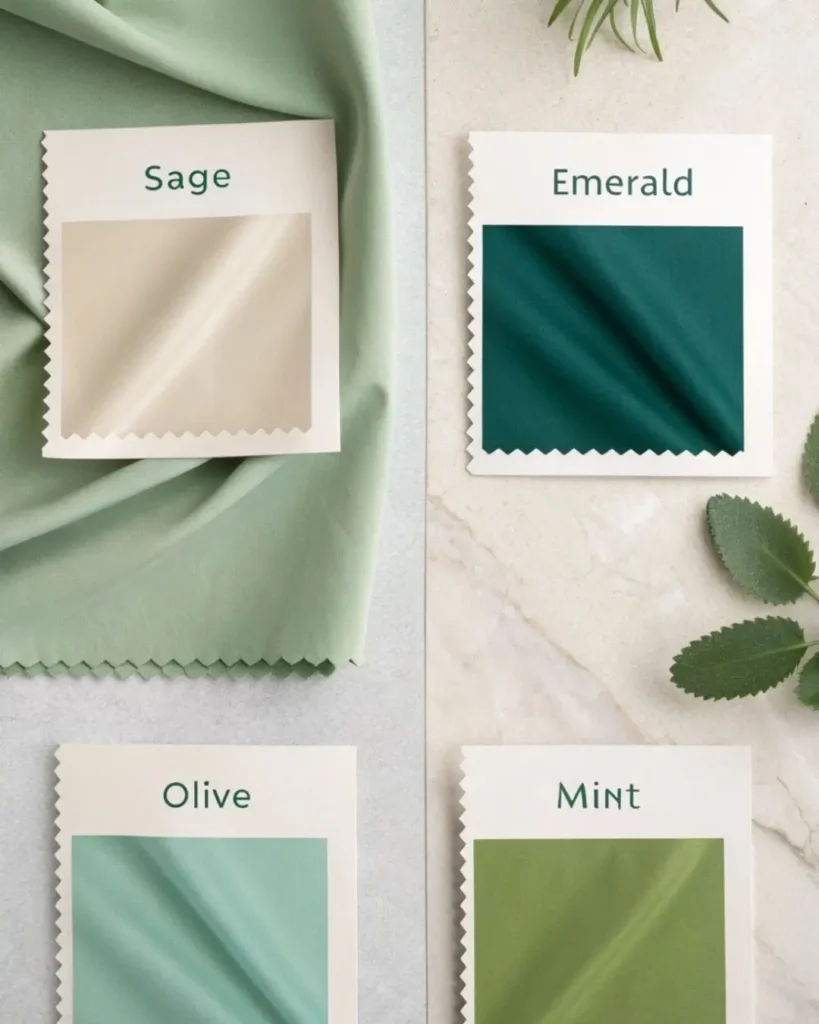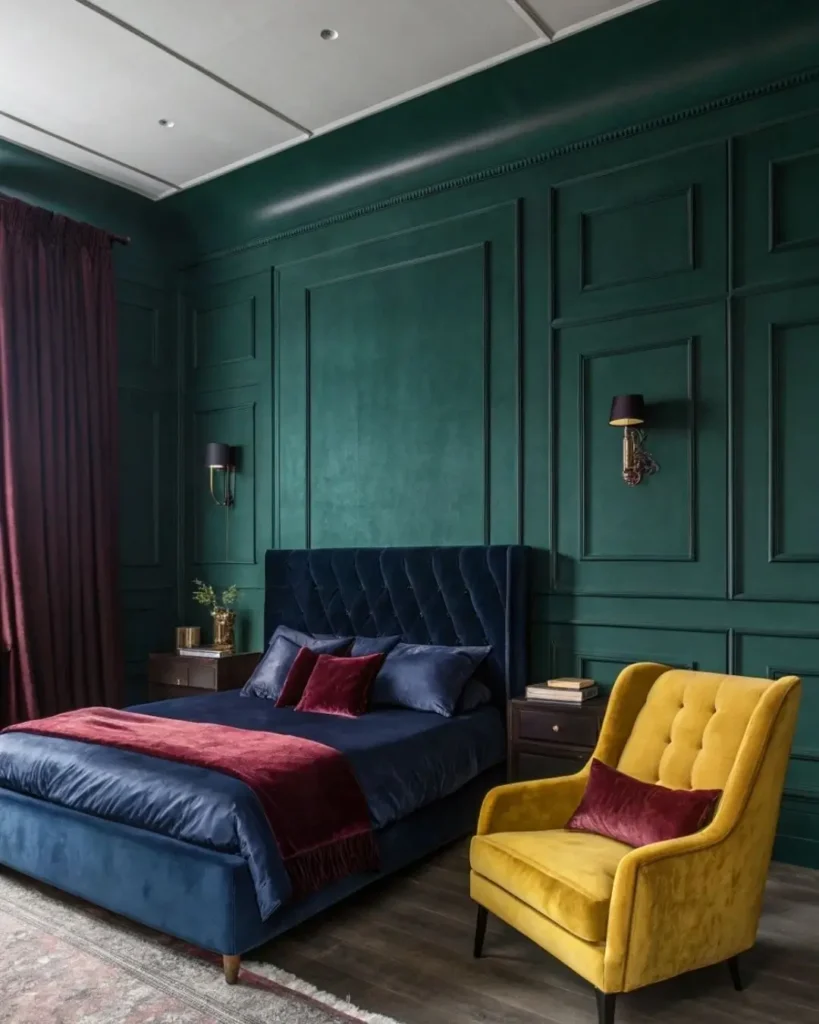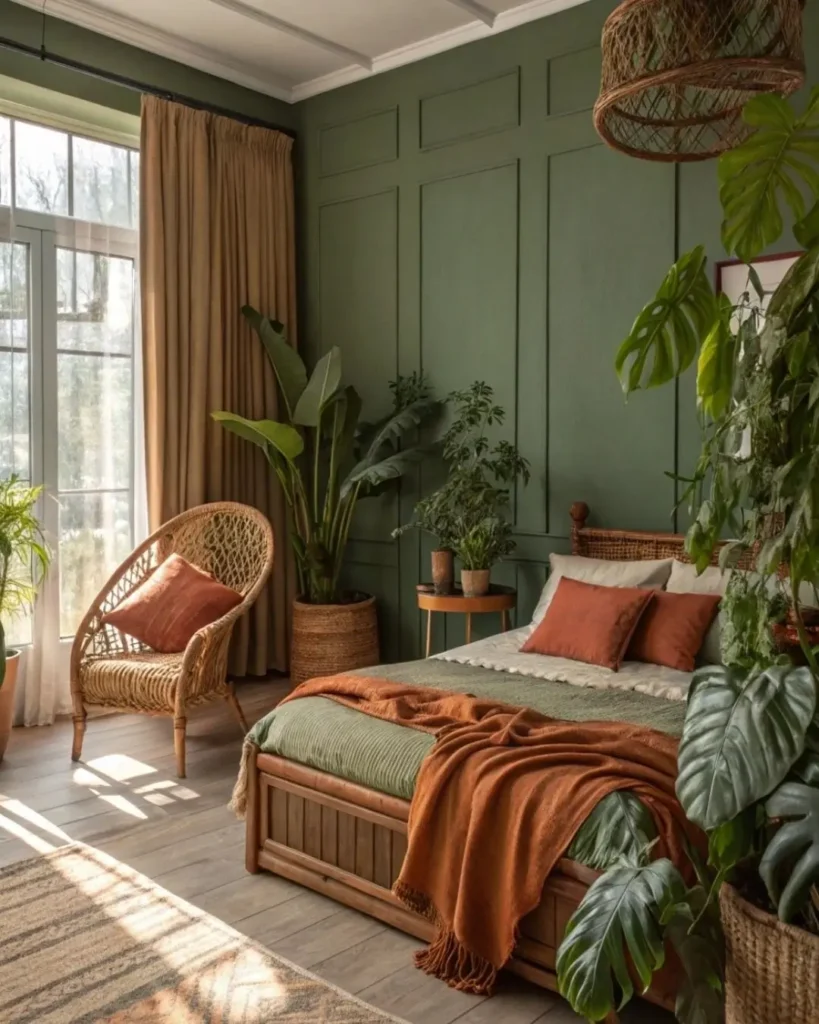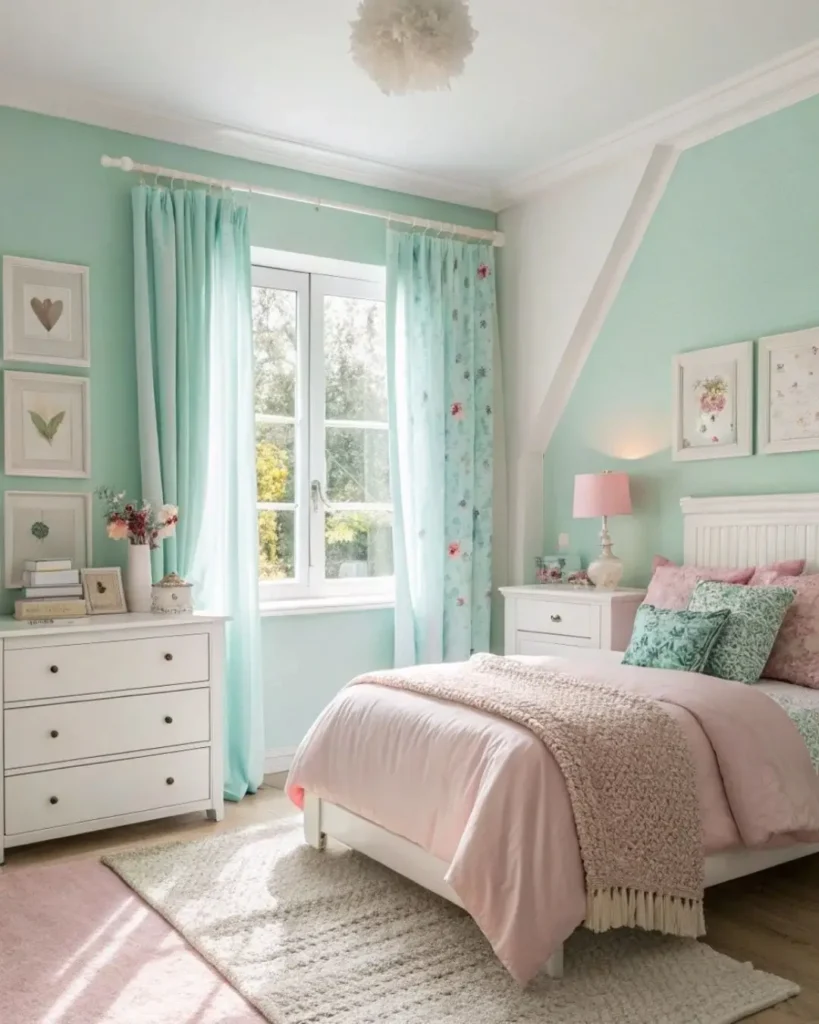Green is a color that’s everywhere in nature—soothing, refreshing, and full of life. So it’s no surprise you’d want it in your bedroom. But once you’ve painted the walls or chosen green bedding, the big question kicks in: what color actually goes well with green in a bedroom?
Believe it or not, many people struggle with this. A bedroom can go from calm and elegant to confusing and mismatched in a heartbeat if you pair green with the wrong hues. The good news? It’s an easy fix—once you know what to look for. Whether you’re working with sage, emerald, olive, or mint, this guide will walk you through the perfect color partners, common pitfalls, and expert-approved solutions.
Let’s explore the stunning secrets to styling green in a bedroom the right way.
1. Mistake: Ignoring the Shade of Green You’re Using

When decorating, many people jump straight to asking, what color goes well with green in a bedroom? without first understanding which green they’re actually working with. This is one of the most common mistakes—and it’s easy to overlook.
Not All Greens Are Created Equal
Green isn’t just “green.” It’s a spectrum ranging from soft, muted tones to deep, dramatic shades. If you assume every green pairs well with the same colors, you risk creating a mismatched or unbalanced space. The key to unlocking a harmonious design lies in recognizing your specific shade of green before choosing complementary colors.
What’s the Fix? Know Your Green
Before asking, what color goes well with green in a bedroom?, take a moment to identify the exact tone you’re using. Each shade brings its own personality and works best with certain partners.If you’re looking for inspiration tailored to different green tones, check out these 15 Stunning Green Bedroom Ideas to Transform Your Space for creative ways to style your room with confidence.
- Sage Green: This soft, muted green has a calming, earthy vibe. It pairs wonderfully with warm neutrals like beige, taupe, or soft blush tones for a serene and cozy feel.
- Emerald Green: Bold and luxurious, emerald demands equally rich companions. Think navy blue, gold accents, or deep charcoal to enhance its jewel-toned elegance.
- Olive Green: A warm, earthy shade that feels grounded and natural. Olive pairs beautifully with terracotta, warm woods, and creamy whites to create a rustic, inviting space.
- Mint Green: Fresh and playful, mint thrives alongside pastels like pale pink, soft yellow, or light gray, giving your bedroom a light and airy atmosphere.
Understanding Undertones: Cool vs. Warm
One expert tip is to determine whether your green leans cool (bluer undertones) or warm (yellower undertones). This will guide you toward colors that naturally complement it. For example, cool greens like mint work better with crisp whites and soft blues, while warm greens like olive shine next to earthy browns and terracotta.
Pro Tip: Use the Color Wheel
If you’re still wondering what color goes well with green in a bedroom?, turn to the classic color wheel. Look for:
- Complementary Colors: Opposite on the wheel, such as reds or pinks for certain greens.
- Analogous Colors: Neighbors on the wheel, like blues and yellows, for a more subtle blend.
Don’t Forget About Lighting
Natural and artificial light dramatically affect how green appears. A sage wall might look grayish in dim light but vibrant during the day. Always test paint samples or fabric swatches in your bedroom’s lighting before finalizing your palette.
By taking the time to understand your green, you’ll make smarter choices when deciding what color goes well with green in a bedroom? This thoughtful approach ensures your space feels cohesive, stylish, and perfectly suited to your personal taste.
2. Pairing with Neutrals: Safe, Sophisticated, and Versatile

Neutrals are always a solid choice. They balance green beautifully and offer a canvas for layering textures.
Best Neutral Matches for Green:
- White: Crisp and clean, great for minimalist spaces
- Beige: Softens the green and adds warmth
- Gray: Modern and grounding, especially with darker greens
- Cream: Cozy and classic, ideal for farmhouse styles
How to use them:
- Use beige or cream for bedding or curtains.
- Paint the trim or ceiling white to keep things bright.
- Incorporate gray through upholstered headboards or area rugs.
This combo is especially good for those who want a relaxing, clutter-free vibe.
3. Going Bold: Green + Jewel Tones or Dark Shades

If you’re not afraid to be a bit daring, jewel tones are your best friend.
Stunning Color Combos:
- Green + Navy: Dramatic and timeless
- Green + Deep Burgundy: Romantic and rich
- Green + Mustard Yellow: Retro yet sophisticated
- Green + Charcoal: Sleek and modern
These shades enhance the drama of green without clashing. For example, a forest green wall paired with navy bedding and gold hardware feels like luxury.
Application Ideas:
- Accent chairs
- Throw pillows and blankets
- Wallpaper or patterned bedding
4. Mistake: Using Too Many Colors at Once
It’s tempting to bring in lots of trendy colors, but too many hues can overwhelm a space—especially when green is already the focus.
Avoid:
- Mixing more than 3 primary colors
- Overusing high-contrast shades without balance
Solution: Stick to the 60-30-10 Rule
- 60% dominant color (walls or bedding)
- 30% secondary color (furniture, rugs)
- 10% accent color (pillows, art, decor)
This simple ratio keeps the space balanced and cohesive.
5. Earthy Pairings: Green + Nature-Inspired Tones

Want your bedroom to feel like a serene forest retreat? Lean into earth tones.
Earth-Inspired Combinations:
- Green + Terracotta: Warm and rustic
- Green + Brown/Wood: Natural and grounding
- Green + Taupe: Subtle and refined
Add in rattan light fixtures, wooden nightstands, or terracotta planters to round out the look.
Benefits:
- Brings warmth to cool greens
- Encourages restfulness
- Works well with plants and natural materials
6. Light & Airy: Pairing Green with Pastels

Pastels are underrated when it comes to bedroom decor, but they pair wonderfully with green—especially lighter shades.
Pastels That Pop with Green:
- Blush Pink: Adds warmth and romance
- Powder Blue: Fresh and clean
- Lavender: Soft and calming
- Pale Yellow: Cheerful and sunny
These combos create a youthful, airy atmosphere—perfect for guest rooms or smaller bedrooms.
7. Textures & Patterns: The Secret Weapon
Color pairing isn’t just about flat tones. Textures and patterns enhance the dynamic between shades and help tie a color scheme together.
Tips for Layering:
- Use velvet, linen, or boucle in complementary tones
- Mix patterned curtains or rugs to incorporate several shades subtly
- Combine matte and glossy finishes (e.g., matte green walls with glossy white dressers)
Quick Table: Textures to Try by Green Shade
| Green Shade | Best Textures | Suggested Material |
| Sage | Soft, matte, natural | Linen, raw wood |
| Emerald | Luxe and rich | Velvet, gold accents |
| Olive | Earthy, cozy | Woven baskets, leather |
| Mint | Clean, airy | Cotton, white ceramics |
8. Lighting Considerations: Why Light Changes Everything
Lighting can change how green and its partner shades appear. That’s why what looks perfect in the store might feel off at home.
Natural vs. Artificial:
- Natural Light: Enhances cooler tones, may make greens appear lighter
- Warm Lighting: Deepens greens and complements warm colors like tan or peach
- Cool Lighting: Works well with crisp whites or gray accents
Quick Tip:
Test your palette under different light conditions before making final decisions. Swatches help, but placing a large sample directly in the room is best.
9. Accent Colors: Pop Without Overpowering
Accent colors can be fun—if you use them strategically. A bold accent adds interest and breaks up monotony, especially in monochromatic green rooms.
Good Accent Colors:
- Gold or brass (light fixtures, handles)
- Coral (pillows, art)
- Black (picture frames, vases)
- White (linen, mirrors)
Just keep your accents purposeful. Too many loud accessories can feel chaotic instead of curated.
10. Common Pitfall: Forgetting the “Feel” You Want
It’s easy to focus on aesthetics and forget about how you want the room to feel. Is your goal calm and restful? Energized and bold? Cozy and warm?
Match Feel to Color Pairing:
- Tranquil: Green + white, beige, or blush
- Cozy: Green + brown, mustard, terracotta
- Bold: Green + navy, charcoal, or black
- Fresh: Green + mint, powder blue, soft pink
Being intentional about the emotion your colors evoke makes your space not only beautiful but personal and livable.
Final Thoughts: Bring Your Green Bedroom to Life
Pairing colors with green in your bedroom doesn’t need to be a guessing game. Whether you’re going for cozy earth tones, modern neutrals, or bold contrasts, the right match can completely transform your space.
Remember:
- Start by identifying your green shade.
- Choose complementary or neutral tones based on mood.
- Stick to the 60-30-10 rule for balance.
- Use lighting and texture to enhance depth and dimension.
If you’re still unsure, don’t hesitate to experiment with mood boards or temporary accents before committing to a full redesign. For more expert advice on home styling and color coordination beyond just figuring out what color goes well with green in a bedroom, explore trusted resources like Martha Stewart for timeless decor inspiration or The Spruce for practical, step-by-step design guides.
FAQs: Everything You Need to Know About Styling Green in Your Bedroom
What color goes with green in a bedroom?
When thinking about what color goes well with green in a bedroom, neutrals like white, beige, gray, and cream are always safe and stylish choices. These shades balance green beautifully, creating a calm and cohesive look. If you’re feeling adventurous, jewel tones like navy or accents of blush pink and mustard yellow can add depth and personality to your space.
What color best complements green?
The best complementary color for green depends on its shade. According to the color wheel, red is directly opposite green, making soft variations like blush or terracotta ideal complements. If you’re wondering what color goes well with green in a bedroom, these warmer tones soften the green while adding a cozy, inviting feel.
What color makes green pop out?
To make green truly stand out, pair it with contrasting tones. Crisp white, deep navy, or even black can make green elements in your bedroom pop. When asking yourself what color goes well with green in a bedroom for a bold effect, think high-contrast pairings that highlight green’s natural vibrance.
What goes with green walls in bedroom?
Green walls offer a versatile backdrop. Neutral furniture, wooden textures, and soft-toned bedding work wonderfully. If you’re still asking what color goes well with green in a bedroom, consider layering in accents like gold fixtures, patterned cushions, or pastel decor for added charm.
What is the complementary color code for green?
On a digital color wheel, green’s complementary color is typically a shade of red or pink. For example, if you’re using a standard green (#00FF00), its complement would be a magenta-red (#FF00FF). This technical detail can help when selecting decor accents or digital design elements. Still, always test combinations in real life to see what color goes well with green in a bedroom under your specific lighting.
Do green and grey go together in a bedroom?
Absolutely! Green and grey are a match made in interior design heaven. Grey tones—whether light dove or deep charcoal—offer a modern, calming contrast to green. If you’re thinking what color goes well with green in a bedroom, grey is a timeless, elegant choice that works with almost any shade of green.
Which color is best for a bedroom?
The best color for a bedroom depends on the mood you want to create. Soft greens, calming blues, and neutral tones are known for promoting relaxation. If you’re wondering what color goes well with green in a bedroom, pairing it with warm neutrals or pastels can enhance tranquility and style.
What color of bedding goes with green walls?
For green walls, opt for bedding in white, beige, blush pink, soft gray, or even subtle patterns that include hints of green. If you’re still debating what color goes well with green in a bedroom, remember that bedding offers a great opportunity to introduce texture and complementary tones without overwhelming the space.


